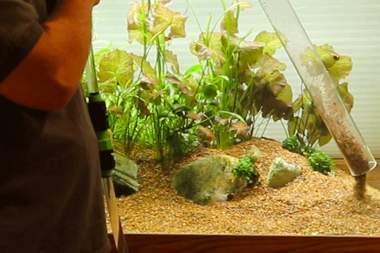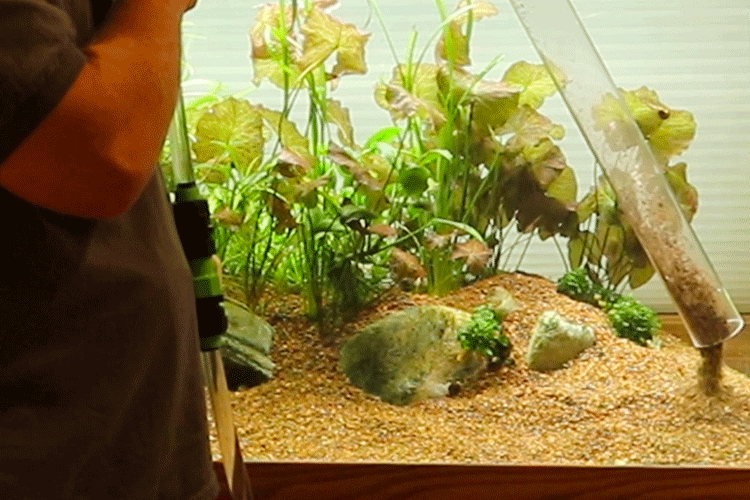 Strategies For Planted Tank Cleaning And Water Changes
Strategies For Planted Tank Cleaning And Water Changes
Today we’re going to go over some useful strategies on how to do a water change and more importantly, a cleaning for a planted tank where you’re keeping discus fish.
I want to share with you some strategies on how to do a water change and a tank cleaning in a planted tank with discus fish or other heavy protein, eating fish. It can get very messy so I’ve got some strategies for you.
Discus To Gallon Ratios
First of all, my friend gave Posada has shared with us, if you keep discus fish, basically you can keep as many as you like but one discus fish per every 10 gallons is a good ratio. So if you have a 55 gallon tank, five to six discus fish is a good amount. But what do you do when you have a large 130 gallon tank?
How Often Do You Need To Do Water Changes?
Well you develop strategies to clean it effectively. One way is you don’t clean it all at once in one setting because as Gabe also mentioned, a 20% water change once a week is sufficient. When you’re cleaning and you only pull out 20% of the water, that doesn’t give you a lot of time to clean the whole tank.
Clean Your Tank In Sections Each Week
The best way to do it is to do it in sections or quadrants. I typically clean about half my tank per 20% water change once a week. The next week I come back and I do the other side with another 20% water change.
Using Planters For Plants In Discus Tanks
Another strategy that I’ve employed over the years is that if you keep a planted tank with a dirted bottom (you have dirt under the gravel or Turface MVP clay bits). I use worm castings underneath for the root systems to draw out nutrients as well as to get themselves rooted. Also within a dirted system when the proteins and dirt of the tank filter through and dissipate down into the soil that also provides a source of fertilizer as well (I augment with various fertilizers as well).
One of the things that I do is I build a planter in the back of the tank for plants. If you notice I have these rocks holding the dirt underneath the gravel in the planter. And then in front of that is all gravel, or in this case Turface MVP clay bits. And so when the proteins get dropped from the fish and obviously their own waste, I clean the gravel first with a tank cleaner. I use a python tank cleaner and I can get it clean pretty quickly without disturbing the dirt underneath the plants. Then I very lightly touch on the top of the gravel or Turface MVP in and around where the plants are.
The Python Tank Cleaner Is Awesome!
Python sells an amazing tank cleaner! The hose quality is top notch and has good silicone tubing and solid fittings. The sink pump has tremendous suction and will last you a long time. I did purchased a longer cleaning tube from Pyton for the end because I have a deeper tank.
I always fill up the tube in the tank first, then let it drop into the tank, so I don’t disturb the tank or plants as it sinks. I then go back to the sink and turn on the water and start pumping out the water.
The python tank cleaner comes with this green pump and it screws into your kitchen or bathroom sink and it basically will draw the water out of your tank or obviously fill it afterwards. It has this little apparatus at the bottom. When it is open, it’s pumping when it’s closed like this, it’s filling. And so that’s how it works. Really simple.
I have this particular filter on the front of my bathroom sink and this unit screws right in. If you have a different size, you can use the python pump without the brass adapter, but they supply a brass adapter for different sink sizes. So you just screw it right in like so. And then you hook your hose right to the end like so.
Again, when it is pushed up it’s filling your tank and when it is pushed down, it is pumping water out from your tank. Then you turn on your faucet and begin to pump the water right out of your discus fish tank.
The Planted Tank Cleaning Process
Clean The Gravel As Normal
When cleaning your tank, the area in front of the planter is all gravel (clay bits), so I can do a thorough cleaning without stirring up the dirt underneath in the planter. Using the tube cleaner I can just clean the gravel the usual way without stirring up the planter.
Clean The Planter Carefully
When moving towards the planter where you have dirt underneath the plants, you just barely shake and touch up the top of the clay bits or gravel. Notice pulling up the dirt, viscous, and junk is easy without disturbing the plants and soil underneath.
Keep Your Systems Running During 20% Water Changes
One of the Nice things that you can accomplish by only doing a 20% water change once per week is that you don’t have to shut off your systems if they’re below the water level. As you can see, my filters are running, my pump and my Co2 are running, my heaters still plugged in and yet I’m able to go through and make a easy water change, not have to turn everything off, just let everything keep running so long as I keep the water level above the heater as well as the intake on the other side for the canister filter. And so it makes it nice and easy. I can go ahead and very quickly do a nice quick cleaning and water change on my tank and not bother the system much at all. All right, so I go ahead and use prime by Sea-Chem.
Remove Chlorine With Prime Or Age Your Water
Aging your water in your garage and then pump aged water without chlorine (chlorine will dissipate from water over time) that’s the best. According to the bottle, one cap-full for each, 50 gallons of added tap water.
What About Temperature Changes?
Another thing that people often ask is, do you need to check your temperature when you begin to fill up your tank again with, with a thermometer. Now discus fish can handle a significant temperature change. Just like in the rainy season in the Amazon river, when the water temperature cools down quite a bit, they start spawning.
Now some of your tetras and other small fish can’t handle a huge temperature swing but as long as you’re close you should be fine. I mix a little warm water at the faucet in with cold tap water. IYou can feel it with your hand and get the matching temperature relatively close. Just so long as it’s not this massive change in temperature you won’t harm your fish. On a smaller tank, obviously you can change your temperature quite rapidly so you must be careful. With a larger tank, it’s not going to swing that fast.
The Benefit Of Two Canister Filters
Also, I keep two canister filters running and whenever I clean them I only do one at a time. And so I’ll go through and on our next video I’ll go over a canister filter cleaning. I like to do one at a time so as not to disturb the general water table over the tank to greatly.
Once you filled your tank, the best way that I’ve found to roll up your hose and not have water still remaining is to turn off the hot water and leave the cold water running to pumping the remaining water from your hose. That way as you begin to roll up your hose, the excess water is sucked out.

